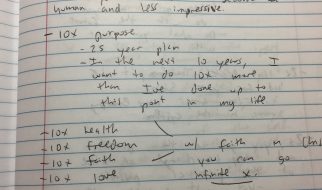The usual methods of copying an object or array only make a shallow copy, so deeply-nested references are a problem. You need a deep copy if a JavaScript object contains other objects.
 Photo by Joo Silas on Unsplash
Photo by Joo Silas on Unsplash
What is a shallow copy?
Making a shallow copy of an array or object means creating new references to the primitive values inside the object, copying them.
That means that changes to the original array will not affect the copied array, which is what would happen if only the reference to the array had been copied (such as would occur with the assignment operator =).
A shallow copy refers to the fact that only one level is copied, and that will work fine for an array or object containing only primitive values.
For objects and arrays containing other objects or arrays, copying these objects requires a deep copy. Otherwise, changes made to the nested references will change the data nested in the original object or array.
In this article, I describe 4 methods of making a shallow copy and then 5 methods of making a deep copy in JavaScript.
 Photo by Jakob Owens on Unsplash
Photo by Jakob Owens on Unsplash
Shallow copy using ?
1. The spread operator (?) is a convenient way to make a shallow copy of an array or object ?when there is no nesting, it works great.
As shown above, the spread operator is useful for creating new instances of arrays that do not behave unexpectedly due to old references. The spread operator is thus useful for adding to an array in React State.
 Photo by Donald Giannatti on Unsplash
Photo by Donald Giannatti on Unsplash
Shallow copy using .slice()
2.For arrays specifically, using the built-in .slice() method works the same as the spread operator ? creating a shallow copy of one level:
 Photo by Antonio Garcia on Unsplash
Photo by Antonio Garcia on Unsplash
Shallow copy using .assign()
3.The same type of shallow copy would be created using Object.assign(), which can be used with any object or array:
 Photo by Pawe? Czerwi?ski on Unsplash
Photo by Pawe? Czerwi?ski on Unsplash
Shallow copy arrays using Array.from()
4.Another method to copy a JavaScript array is using Array.from(), which will also make a shallow copy, as shown in this example:
If an object or array contains other objects or arrays, shallow copies will work unexpectedly, because nested objects are not actually cloned.
For deeply-nested objects, a deep copy will be needed. I explain why below.
 Photo by brabus biturbo on Unsplash
Photo by brabus biturbo on Unsplash
Watch out for the deeply-nested Gotcha!
On the other hand, when JavaScript objects including arrays are deeply nested, the spread operator only copies the first level with a new reference, but the deeper values are still linked together.
To solve this problem requires creating a deep copy, as opposed to a shallow copy. Deep copies can be made using lodash, rfdc, or the R.clone() method from the Ramda functional programming library. I explore deep copies next.
Photo by Landon Martin on Unsplash
What is a deep copy?
For objects and arrays containing other objects or arrays, copying these objects requires a deep copy. Otherwise, changes made to the nested references will change the data nested in the original object or array.
This is compared to a shallow copy, which works fine for an object or array containing only primitive values, but will fail for any object or array that has nested references to other objects or arrays.
Understanding the difference between == and === can help visually see the difference between shallow and deep copy, as the strict equality operator (===) shows that the nested references are the same:
I will cover 5 methods of making a deep copy (or deep clone): lodash, Ramda, a custom function, JSON.parse() / JSON.stringify(), and rfdc.
 Photo by mya thet khine on Unsplash
Photo by mya thet khine on Unsplash
Deep copy with lodash
1.The library lodash is the most common way JavaScript developers make a deep copy. It is surprisingly easy to use:
Lodash?s name comes from the library being referenced as an underscore (_), a ?low dash? or lodash for short.
 Photo by Annie Spratt on Unsplash
Photo by Annie Spratt on Unsplash
Deep copy with Ramda
2.The functional programming library Ramda includes the R.clone() method, which makes a deep copy of an object or array.
Note that R.clone() from Ramda is equivalent to _.cloneDeep() for lodash, as Ramda does not have a shallow copy helper method.
 Photo by Roi Dimor on Unsplash
Photo by Roi Dimor on Unsplash
Deep copy with custom function
3. It is pretty easy to write a recursive JavaScript function that will make a deep copy of nested objects or arrays. Here is an example:
Note that I also need to check for null since the typeof null is ?object.?
 Photo by Scott Webb on Unsplash
Photo by Scott Webb on Unsplash
Deep copy with JSON.parse/stringify
4. If your data fits the specifications (see below), then JSON.parse followed by JSON.stringify will deep copy your object.
?If you do not use Dates, functions, undefined, Infinity, [NaN], RegExps, Maps, Sets, Blobs, FileLists, ImageDatas, sparse Arrays, Typed Arrays or other complex types within your object, a very simple one liner to deep clone an object is: JSON.parse(JSON.stringify(object))? ? Dan Dascalescu in his StackOverflow answer
To demonstrate some reasons why this method is not generally recommended, here is an example of creating a deep copy using JSON.parse(JSON.stringify(object)):
A custom function or the libraries mentioned can make a deep copy without needing to worry about the type of the contents, though circular references will trip all of them up.
Next I discuss a blazing-fast library called rfdc that can handle circular references while being as fast as a custom deep copy function.
 Photo by Scott Webb on Unsplash
Photo by Scott Webb on Unsplash
Really fast deep copy? Think rfdc
5. For the best performance, the library rfdc (Really Fast Deep Clone) will deep copy about 400% faster than lodash?s _.cloneDeep:
?rdfc clones all JSON types: ?Object ?Array ?Number ?String ?null
With additional support for: ?Date (copied) ?undefined (copied) ?Function (referenced) ?AsyncFunction (referenced) ?GeneratorFunction (referenced) ?arguments (copied to a normal object)
All other types have output values that match the output of JSON.parse(JSON.stringify(o)).? ?rfdc Documentation
Using rfdc is pretty straight-forward, much like the other libraries:
The rfdc library supports all types and also supports circular references with an optional flag that decreases performance by about 25%.
Circular references will break the other deep copy algorithms discussed.
Such a library would be useful if you are dealing with a large, complex object such as one loaded from JSON files from 3MB-15MB in size.
Here are the benchmarks, showing rfdc is about 400% faster when dealing with such large objects:
benchLodashCloneDeep*100: 1461.134msbenchRfdc*100: 323.899msbenchRfdcCircles*100: 384.561ms ? rfdc Documentation
- The library rfdc (Really Fast Deep Clone) is on GitHub and npm:
davidmarkclements/rfdc
Really Fast Deep Clone. Contribute to davidmarkclements/rfdc development by creating an account on GitHub.
github.com
rfdc
Really Fast Deep Clone
www.npmjs.com
 Photo by Scott Webb on Unsplash
Photo by Scott Webb on Unsplash
Performance of JavaScript Copy Algorithms
Of the various copy algorithms, the shallow copies are the fastest, followed by deep copies using a custom function or rfdc:
?Deep copy by performance: Ranked from best to worst
Reassignment ?=? (string arrays, number arrays ? only)
Slice (string arrays, number arrays ? only)
Concatenation (string arrays, number arrays ? only)
Custom function: for-loop or recursive copy
[Author?s note: rfdc would be here, as fast as a custom function]
jQuery?s $.extend
JSON.parse (string arrays, number arrays, object arrays ? only)
Underscore.js?s _.clone (string arrays, number arrays ? only)
Lo-Dash?s _.cloneDeep? ? Tim Montague in his StackOverflow answer
Using JSON.parse/JSON.stringify creates issues around data types, so rfdc is recommended ? unless you want to write a custom function.
 Photo by Keila Htzel on Unsplash
Photo by Keila Htzel on Unsplash
Conclusion
It is actually pretty easy to avoid needing to deep copy in JavaScript ? if you can just never nest objects and arrays inside each other.
Because in that case ? where there is no nesting and the objects and arrays only contain primitive values ? making a shallow copy with the spread operator (?), .slice(), and .assign() all work great.
But, in the real world, where objects have arrays inside them, or vice versa, then a deep copy will need to be used. I recommend rfdc for deep clones.
(Note that some may also suggest using JSON.stringify() followed by JSON.parse(), but that is not a reliable way to make a deep copy.)
Now get out there and deep copy some nested objects!
 Photo by Kristina Evstifeeva on Unsplash
Photo by Kristina Evstifeeva on Unsplash
Further reading
- Alligator.io has a great article on deep cloning using lodash:
Deep Cloning Objects In JavaScript (And How It Works)
If you plan on coding with JavaScript, you need to understand how objects work. They’re one of the most important?
alligator.io
- Samantha Ming explains shallow and deep copies on dev.to:
How to Deep Clone an Array in JavaScript
There are 2 types of array cloning: shallow & deep. Shallow copies only cover the 1st level of the array and the rest?
dev.to
- Peter Tasker?s article on dev.to generated many comments, including an explanation of when JSON.parse(JSON.stringify(obj)) fails:
Best way to copy an object in JavaScript?
So I’m always looking for a way to use vanilla JS whenever possible these days, and I discovered that deep copying an?
dev.to
- James Dorr covers the need to copy when adding to an array to React State (since React State is immutable) in JavaScript in Plain English:
.setState() Not Working ? Shallow Copy vs Deep Copy & Lodash
Shallow Copy vs Deep Copy & Lodash
Shallow Copy vs Deep Copy & Lodashmedium.com
- Ramn Miklus uses immutability-helper, a library used to maintain the immutability of data, instead of lodash to deep copy on Codementor:
Deep copying an object in JavaScript | Codementor
Using the spread syntax or Object.assign() is a standard way of copying an object in JavaScript. Both methdologies can?
www.codementor.io
- Speaking of immutability, Gabriel Lebec has a great guide in dev.to:
Four Ways to Immutability in JavaScript
This article presents four different techniques to immutably update data structures in JavaScript: Many of the code?
dev.to
 Photo by ? ? on Unsplash
Photo by ? ? on Unsplash


